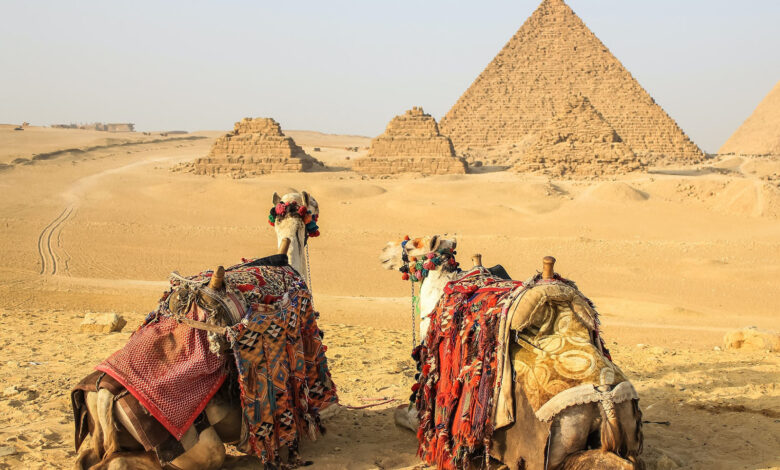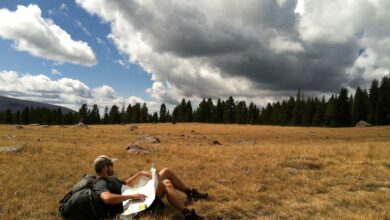
Heads up: some of the links on this site are affiliate links. If you click and make a booking or purchase, I’ll make a commission (at no extra cost to you). I partner with companies I personally use and the $$ goes towards creating more awesome, free travel content.
Egypt is an incredible country and there is SO much to see and do that it’s quite overwhelming trying to plan the perfect itinerary.
When I booked my trip to Egypt I ideally wanted to visit for 10 days but I found ridiculously affordable flights ($490 round-trip from New York) and the dates dictated I would only have 7 days in the country.
With only one week in Egypt, it was difficult to know what to include. Should I skip Abu Simbel? Do I need to do a Nile cruise? Should I stay near the pyramids? These were some of the questions I asked myself.
I’ve done this exact Egypt itinerary, so I know it works. It includes Abu Simbel but doesn’t include a Nile cruise because many of the cruises are multi-day cruises and 7 days in Egypt isn’t a lot of time to fit one in.
However, you’ll still be able to cover important places such as Cairo, Aswan, Abu Simbel and Luxor. You’ll get to see the Pyramids, Philae Temple, Karnak Temple, The Valley of the Kings and a bunch of other cool places. It’s a great Egypt itinerary for first-timers and quite a typical route.
While you can do a package tour with a set itinerary, the tour companies charge a markup so you’re paying more for the convenience of having someone else organizing everything for you.
Egypt really wasn’t as difficult as people made it out to be and the hassle wasn’t really that bad. It’s perfectly possible to do a DIY itinerary to Egypt and book everything yourself.
Just book your domestic flights (or trains) online and then book day tours and individual activities through GetYourGuide or Viator. This is a much cheaper way of doing things than booking a 7-day tour that’s planned from start to finish.
So without further ado, here’s how to spend one week in Egypt:
Egypt Itinerary: 7 Days in the Land of the Pharaohs
When you fly into Egypt you’ll land at Cairo International Airport. If you don’t mind moving around, you could stay one night at a hotel near the Pyramids and then one night near Tahrir Square or in Zamalek. This allows you to have the experience of enjoying breakfast with a view of the pyramids but then also experience the hustle and bustle of downtown Cairo.
Days 1 & 2: Cairo
Where to Stay in Cairo
Marriott Mena House – This is the best hotel in Cairo, so if you can afford to stay a night here, definitely do! The hotel has welcomed many celebrities and dignitaries over the years and has beautiful, lush gardens with a view of the Pyramids of Giza. The resort boasts an outdoor pool, a 24-hour gym, an on-site spa and several restaurants offering different cuisines. The luxurious rooms all have private balconies with views of the pool, gardens or the Pyramids.
Pyramids Eyes Hotel– If you can’t afford to stay at Marriott Mena House, there are a number of budget options that all have rooftops with views of the Pyramids of Giza. One of them is the Pyramids Eyes Hotel, which is a boutique hotel with just 17 rooms. The hotel is just a 10-minute walk from the entrance to the Pyramids and has a rooftop cafe where you can enjoy complimentary breakfast and hookah available for purchase.
Steigenberger Hotel El Tahrir Cairo – If you want to stay in the downtown area near Tahrir Square, this hotel is a comfortable and affordable option. Located within walking distance of the Egyptian Museum, the hotel offers 295 modern rooms, free WiFi, 24 hour in-room dining/room service, an all-day dining restaurant and a lobby bar where you can enjoy cocktails after a long day of sightseeing.
The Nile Ritz-Carlton – The most luxurious option in downtown Cairo, The Nile Ritz-Carlton is located in the heart of the Nile, close to the Egyptian Museum and Tahrir Square. This stunning hotel has nine dining options, a rooftop lounge, an olympic-sized pool, fitness center and tastefully appointed rooms overlooking the river Nile.
President Hotel Zamalek – If you’d prefer to stay in Zamalek (one of the most affluent areas of Cairo), the President Hotel is an excellent option. Rooms are modern and there are a number of dining options within the hotel, including a rooftop breakfast restaurant with views of the capital and a cellar restaurant serving both oriental and international dishes.
Pyramids of Giza and Sphinx
Start your trip with the most iconic landmark in Egypt, the Pyramids of Giza! The best way to visit the Pyramids is by taking a guided tour so that you can avoid any scams and hassle. Sometimes people will stand near the entrances telling people they’re going the wrong way or they’ll try and hassle you into taking a camel ride. If you have a guide, you won’t run into this problem.
The Pyramids of Giza are a set of three pyramids that were built between 2550 to 2490 B.C. Egyptian Pharaohs believed in an afterlife and to prepare for entry into the next world they built tombs for themselves that contained everything they would need in the next life. The Pyramids of Giza were therefore built to house the remains of the deceased pharaohs after they died.
The Great Pyramid is the largest one and was built with an estimated 2.3 million large blocks weighing 6 million tonnes in total. Built for the pharaoh Khufu, the pyramid was the tallest man-made structure in the world for around 3,000 years, standing around 481 feet (147 meters) above the plateau.
The Pyramid of Khafre is the second largest of the pyramids and was built for the 4th dynasty Pharaoh Khafre. The southernmost and smallest pyramid was the tomb of Menkaure, the fifth pharaoh of the 4th dynasty.
All three of the pyramids were looted during ancient and medieval times and so the tombs were left pretty much empty. None of the bodies or treasures that were buried with the kings have been found inside the pyramids.
There are conspiracy theories that the pyramids were built by aliens but in fact the pyramids were built over several decades by thousands of workers. They all lived in a worker’s village close to the plateau, which featured sleeping quarters, bakeries, breweries, kitchens, a hospital and even a cemetery.
Your guide will take you on a tour of the three pyramids and you’ll have the option to add a camel ride to your experience. You’ll be able to capture photos of the Pyramids of Giza from lots of different angles and you can even pay to go inside them. I wouldn’t bother with going inside though – it’s cramped and you won’t see any contents inside them since everything has been robbed/removed.
After visiting the Pyramids of Giza it’s time to head to the Great Sphinx of Giza, which is a statue of a mythical creature that’s half human, half lion. It measures 73 m (240 ft) long from paw to tail and is one of the most iconic sculptures in the world. The statue was cut out of the bedrock and archeologists believe it dates back to the reign of Khafre (c. 2558–2532 BC).
Egyptian Museum
In the afternoon, head to the Egyptian Museum, which houses the largest collection of Pharaonic antiquities in the world. The building was designed by French architect Marcel Dourgnon as part of an international design competition and it has become an iconic fixture of downtown Cairo. Spread over two floors, it contains over 170,000 objects from the beginning of the Old Kingdom of Ancient Egypt all the way through to the Greco-Roman period.
On display you’ll see extensive collections of papryi, sarcophagi, jewelry, canopic jars, coins, and other Egyptian artifacts. You can also see the mummies of some of Egypt’s greatest Pharaohs and the contents of Tutankhamun’s tomb, including his solid gold funerary mask.
Other highlights of the museum include:
- Treasures discovered in the Royal Tombs of Tanis
- The complete burials of Yuya and Thuya
- The Narmer Palette, which depicts the unification of Upper and Lower Egypt under King Narmer.
- Statues of kings Khufu, Khafre, and Menkaure, who were the builders of the Pyramids of Giza.
Note: The Egyptian Museum is due to be superseded by the Grand Egyptian Museum, which is still under construction and is slated to open in 2023. The museum will house the complete Tutankhamun collection and is set to be the largest archeological museum in the world.
Food Tour
In the afternoon/evening I’d suggest doing a food tour so you can sample some of Egypt’s most popular dishes. Or, if you’re comfortable wandering around by yourself, there are plenty of places to eat in downtown Cairo not far from Tahrir Square and the Egyptian Museum.
Some popular dishes to try in Cairo include:
Koshary – A popular street food/national dish that consists of macaroni, rice and brown lentils, topped with a tomato-based sauce and vinegar. It’s then garnished with crispy onions and chickpeas. You can find koshary shops all over the city – if you’re in downtown Cairo check out Abou Tarek or Al Tahreer Koshary.
Shawarma – Shawarma is a huge cone of pressed chicken or lamb that’s rotated on a vertical rotisserie in front of a flame grill. When you order this popular takeaway dish the meat is sliced off and placed on a griddle with a mixture of tomato, onion and parsley. It’s then placed on a circular flatbread and rolled up into foil to eat like a sandwich.
Pigeon – A delicacy in Egypt, pigeon is stuffed with seasoned rice or bulgar wheat and then baked or grilled to make it nice and crispy. I tried it and it was OK, though it’s not something I’d eat again.
Orzo Soup – Wherever you eat throughout Egypt they’ll usually bring out this tasty orzo soup. I believe it’s called lesan asfour and it’s basically a tasty clear broth with orzo in it. It’s usually served with a small bitter citrus fruit that you can squeeze into your soup.
Day 2: Coptic Cairo, Citadel, Kaaan el ali
Coptic Cairo
Start day 2 of your Egypt itinerary with a visit to see Coptic Cairo. Coptic Cairo is located south of downtown Cairo and is part of ‘Old Cairo’, which was the original city center for centuries.
Coptic Cairo was the stronghold of Christianity in Egypt and is home to sights such as the Hanging Church, the Babylon Fortress, the Coptic Museum and the Greek Church of St. George. Here you can see Egypt’s oldest churches, some of which date back to back to the 4th century AD, before Islam had arrived in the country.
You’ll also find significant Jewish and Islamic places of worship here, including the Mosque of Amr Ibn al-Aas – the oldest mosque in Cairo – and Ben Ezra Synagogue.
To get to Coptic Cairo you can take an Uber, or you can book a tour using Viator or GetYourGuide. Churches are usually open from 8am to 4pm and entrance is free.
Citadel
Next up you’re going to head north east to the Citadel, which is one of the most beautiful buildings in Cairo. Its construction was ordered by Salah El Din, who overthrew the Fatimid dynasty and decided to improve the fortifications of the city to protect it from European crusader armies. This impressive fortification was completed in 1183 AD and served as the seat of the Egyptian government for over 700 years.
Over the years the Citadel was remodeled and expanded by many different rulers, who left behind a collection of three mosques and various palaces, which now house museums. One of the highlights is the Alabaster Mosque, which was built for Muhammed Ali, in memory of his deceased son.
The views from the Citadel’s terraces are incredible and on a clear day you can even see all the way to the Pyramids of Giza. Visiting the Citadel was the highlight of my time in Cairo and I actually preferred it to the pyramids.
Khan el-Khalili Souk
Khan el-Khalili souk is Egypt’s most famous market and is filled with all sorts of stalls selling spices, lanterns, perfumes, scarves and other Egyptian souvenirs. The market has existed since the 14th century and was built on the site of an old mausoleum in the Islamic part of Cairo.
Even if you don’t want to buy anything, it’s fun to walk through the market and stop at one of the Arabic coffee houses. Sit down, order some mint tea (or coffee if you need some energy), smoke some shisha and just watch the world go by.
Transfer to Aswan
On day 2 you could take an evening flight from Cairo to Aswan or the deluxe sleeper train to Aswan. Alternatively you could stay over in Cairo and catch an early morning flight to Aswan.
Days 3 & 4: Aswan & Abu Simbel
Where to Stay in Aswan
Obelisk Nile Hotel – This is where I stayed during my time in Aswan. Rooms are affordable yet comfortable and either have garden views or views of the Nile River. There’s a lovely pool, a restaurant with buffet breakfast and a terrace café where you can watch the sun set over the River Nile.
Sofitel Legend Old Cataract – Aswan’s most iconic hotel, the Sofitel Legend Old Cataract is a 19th century Victorian Palace that sits on the banks of the Nile opposite Elephantine Island. The hotel has welcomed many famous guests and dignitaries over the years, including King Fouad and Agatha Christie.
Kendaka Nubian House – If you’d prefer to stay in the Nubian Village for the night, check-out Kendaka Nubian House. This small guesthouse features nine rooms decorated in bright colors, some of which have river views. Amenities include 24 hour front reception,free local breakfast, free WiFi and a terrace restaurant with river views.
Day 3: Abu Simbel
I’ve written a lengthy post about all the different ways to get to Abu Simbel here. For simplicity, here’s how I did it. I flew from Cairo to Aswan in the early morning on day 3. This was the first flight out of Cairo. I then dropped my bags off at my hotel and did a private tour to Abu Simbel by land departing around 9am.
It was a bit of a tight turnaround, so ideally it would be better to fly down to Aswan at night on day 2 if you can. You can get a good night’s sleep and then be all fresh for your tour to Abu Simbel.
There are shared tours to Abu Simbel, which are cheaper, but I’d advise against doing those. You have to depart very early in the morning around 5am and you’ll be visiting along with bus loads of tourists. All the shared tours depart at the same time so as you can imagine, Abu Simbel is swarming with people by about 8am. It’s incredibly difficult to take epic photos when you’re lining up with hundreds of other tourists!
By taking a private tour, like this one from Viator, you can depart much later and you’ll have Abu Simbel all to yourself, like I did. You have the option to just hire a driver, or you can have a private guide as well to accompany you.
Now I did skip one other way to get to Abu Simbel, but it’s a viable option. Egyptair operates a flight that goes from Cairo-Aswan-Abu Simbel-Aswan. It lands in Aswan for a short technical stop (some people get off here) and then continues onwards to Abu simbel. A coach will be waiting to take you and the other passengers to the temple. You’ll have a few hours at Abu Simbel and then the coach will take you back again to the airport. From Abu Simbel you’ll then fly back to Aswan.
This route can be booked as a multi-trip journey but if you have carry-on bags you can’t leave them on the plane and I wouldn’t risk leaving them on the coach. Your checked bags will be checked all the way through to Aswan but you’d have to take your carry-on bag to Abu Simbel. It’s also more expensive to fly to Abu Simbel than to go by land, so that’s another factor to consider.
Whichever way you get there, Abu Simbel is incredible. It’s a real bucket list experience.
Once you’re back in Aswan I’d suggest venturing outside of your hotel so you can have dinner at El Masry, which is one of the best Egyptian restaurants in Aswan.
Day 4: Philae Temple and the Nubian Village
Today it’s time to explore the sights of Aswan! There are quite a few things to do in Aswan but the main highlights are the Philae Temple and the Nubian Village.
Start your day with breakfast at the hotel then take a boat ride to Philae Temple. This temple is located on Agilkia Island in the reservoir of the Aswan Low Dam and is one of the most famous places to visit in Aswan.
It was originally located on Philae Island, but was relocated to its current location as part of a UNESCO campaign project to save important Nubian monuments from flooding created by the construction of the dam.
Philae Temple is home to the Temple of Isis, which was built during Egypt’s Greco-Roman Period and is dedicated to the gods Isis, Osiris, and Horus. The temple walls depict scenes of Isis bringing Osiris back to life, giving birth to Horus, and mummifying Osiris after his death.
I’m no expert in Egyptian history but I will say the temple is incredibly picturesque and if you’re looking for the best place to grab photos at Philae, there’s a cool stone window that frames a beautiful view of the water.
Next up it’s time to hop on a boat to the Nubian Village, which is located on the west bank of the Nile. I’ve written a full post about visiting the Nubian village here. The Nubian people paint their homes in a kaleidoscope of colors and keep baby crocodiles in their homes for luck.
On your visit to the Nubian Village you can see inside a Nubian home, purchase spices, have henna tattoos or just wander around and take photos of all the colorful murals. There are numerous tours that will take you to both Philae Temple and the Nubian Village, or you can negotiate your own boat ride in Aswan.
Train to Luxor
In the late afternoon/evening, head to the station to catch the train from Aswan to Luxor. Tickets can be purchased at the ticket offices in the station or at the self-service machines. You can also buy online through the Egypt National Railways website, although it’s not very user friendly.
The train I took did not depart on time. It departed about 40 minutes late and the air-conditioning made the temperature so cold that I felt like I was sitting in an ice box. However, the train was comfortable and the train car was full of other tourists, so I could tell it was a popular way to get from Aswan to Luxor.
You can’t fly between the two cities, so your only other option would be to book a private car to take you there. Expect to pay approx $100 for a private car transfer one-way.
Days 5 & 6: Luxor
Yay, you made it to Luxor! The next two days will be spent exploring all the major sights in Luxor, including the Valley of the Kings, the Valley of the Queens, Karnak Temple and Luxor Temple. While I loved the relaxed vibe in Aswan, I found Luxor to be the most exciting place I visited in Egypt in terms of temples and ancient sites.
Nothing compares to Karnak Temple, which was my favorite temple in Egypt!
Where to Stay in Luxor
Sofitel Winter Palace – The Sofitel Winter Palace is an iconic hotel and the absolute best place to stay on your first time in Luxor. Dating back to 1886, this historic hotel boasts lush tropical gardens, palatial rooms, a beautiful pool and several on-site restaurants. Best of all it’s located just a stone’s throw from Luxor Temple, right on the banks of the Nile.
Hilton Luxor Resort & Spa – If you’d prefer a more modern hotel, book a room at the Hilton Luxor, which is located closer to Karnak Temple. Its location is a bit out of the way but the hotel is one of the best and most luxurious in Luxor. Facilities include a Nile-view infinity pool, an outdoor thermal garden, an authentic shisha café, three restaurants and a spa with 12 treatment rooms.
Steigenberger Nile Palace – One of the best affordable options in Luxor, the Steigenberger Nile Palace boasts a central location in downtown Luxor. Its 303 rooms and suites have balconies or terraces with views of the city, the courtyard, or the Nile and its surrounding mountains.
Day 5: Valley of the Kings, Valley of the Queens
On day 5 of your trip you’ll be exploring Luxor’s west bank, which is where you’ll find the Valley of the Kings and the Valley of the Queens.
Valley of the Kings
The Valley of the Kings is a valley on the west bank of the Nile that served as the burial site for numerous important pharaohs and nobles of the 18th, 19th and 20th dynasties.
The tombs are carved deep into the mountains, which consist of limestone and sedimentary rock. While each tomb is different, the layout typically consists of a long corridor with a burial chamber at the end. Inside the tomb is a stone sarcophagus that would’ve contained the mummified body of the deceased pharaoh. Treasures such as furniture, clothes and jewelry were placed around the chamber, meant for the pharaoh’s use in the next world.
A total of 63 tombs and chambers have been discovered in the valley, including the tomb of Tutankhamun, which was discovered almost entirely intact. Many of the tombs are decorated with incredible paintings and carvings depicting scenes from Egyptian mythology.
Valley of the Queens
The Valley of the Queens is where the wives of the pharaohs (and some of their children) were buried in the period 1292–1075 BC . There are over 90 tombs in the Valley of the Queens, with the most notable one being the tomb of Nefertari, who was Ramses II’s favorite wife. Archeologists believe the first tomb to be constructed was the tomb of princess Ahmose, who was daughter of King Seqenenre and Queen Sitdjehuti.
The tombs at the Valley of the Queens were discovered by Italian Egyptologist Ernest Schiaparelli in 1904, but sadly the tombs had already been emptied of their treasures.
Mortuary Temple of Hatshepsut
One of the most impressive temples in Luxor is the Mortuary Temple of Hatshepsut, which was built during the reign of Queen Hatshepsut. Hatshepsut was one of the few female pharaohs to rule over Egypt (only the second after Sobekneferu) and came to power in 1478 BC.
The temple is dedicated to the solar deity Amon-Ra and consists of three terraces that are built into the cliffs of Deir el-Bahari.
Colossi of Memnon
Tours of Luxor also usually take tourists to visit the Colossi of Memnon, which are two statues constructed in the image of pharaoh Amenhotep III. By his feet are two smaller statues depicting his wife and his mother.
The Colossi of Memnon were constructed at the entrance to what was once Amenhotep III’ mortuary temple, but sadly this was destroyed by an earthquake not long after it was built.
Day 6: Karnak Temple, Luxor Temple
Spend your second day in Luxor exploring the east bank including Karnak Temple and Luxor Temple. You could also throw in visits to the Luxor Museum and the Mummification Museum if you have time. Or if you’d prefer to have a more leisurely day, skip the museums and soak up the sun by your hotel pool, then enjoy a sunset felucca ride on the Nile.
Karnak Temple
Karnak Temple was my favorite temple in the whole of Egypt. This sprawling temple complex is the largest building ever to be constructed for religious purposes and was developed over a period of 1500 years.
The temple consists of various temples, chapels and pylons, and was dedicated to the gods Amun, Mut, and Khonsu. It held great religious significance during the New Kingdom and new generations of Pharaohs made additions to its structure over the years.
Construction even continued well into the Greco-Roman Period, with the Ptolemies, Romans, and early Christians all making contributions to it. The columns are absolutely enormous and look beautiful when the sun shines between them in the late afternoon.
Luxor Temple
Located right in the heart of Luxor is Luxor Temple, which was constructed from sandstone blocks from Nubia in around 1400 BCE. While most of the temples in Luxor were dedicated to gods or deified versions of the kings and pharaohs, this one is not. Luxor temple is dedicated to the rejuvenation of kingship and it’s thought that many pharaohs may have been crowned here.
Some parts of the temple were built by Tutankhamun and Ramesses II, while the chapels to the rear of the temple were built by Amenhotep III and Alexander.
A highlight of the temple is The Great Colonnade Hall, which measures almost 61 meters long and consists of 28 twenty-one-foot-high columns.
Day 7: Hot Air Balloon Ride, Relax, Home
On day 7 it’s time to make your way back to Cairo and say goodbye to Egypt!
Since the hot air balloon excursions start very early in the morning (you’ll have a nice 4am start!) you could save this for your last day in Egypt. A hot air balloon ride is a memorable experience and will allow you to see some magnificent views over Luxor. You’ll be back in the morning, which gives you enough time to get to the airport.
You catch a domestic flight from Luxor to Cairo, then board your international flight. Try to allow yourself at least 3-4 hours between flights in case something happens and your flight from Luxor to Cairo is delayed. You don’t want to miss your flight home!
If you have some spare time in the morning I’d suggest relaxing at the pool in your hotel in Luxor. Have a nice breakfast and rest. It only takes about 15 minutes to get from downtown Luxor to the airport by taxi, so you don’t need much time at all to get there.
Once at Cairo Airport, remember to change any leftover Egyptian pounds before you go through security. I didn’t realize this but there is no money changer after airport security. You’ll get a much better exchange rate changing your Egyptian pounds in Egypt than you will at a money changer back home.
A Final Word…
Egypt is an incredible place. Until you go there it’s difficult to imagine how impressive the Egyptian temples really are. This 7 day Egypt itinerary will allow you to scratch the surface, but there’s also so much more to explore. If you have more time in Egypt you could visit Siwa Oasis, Alexandria, Hurghada, Sharm el Sheikh and a bunch of other places. But if you only have one week, this itinerary is still a great introduction to the country!
Source link






